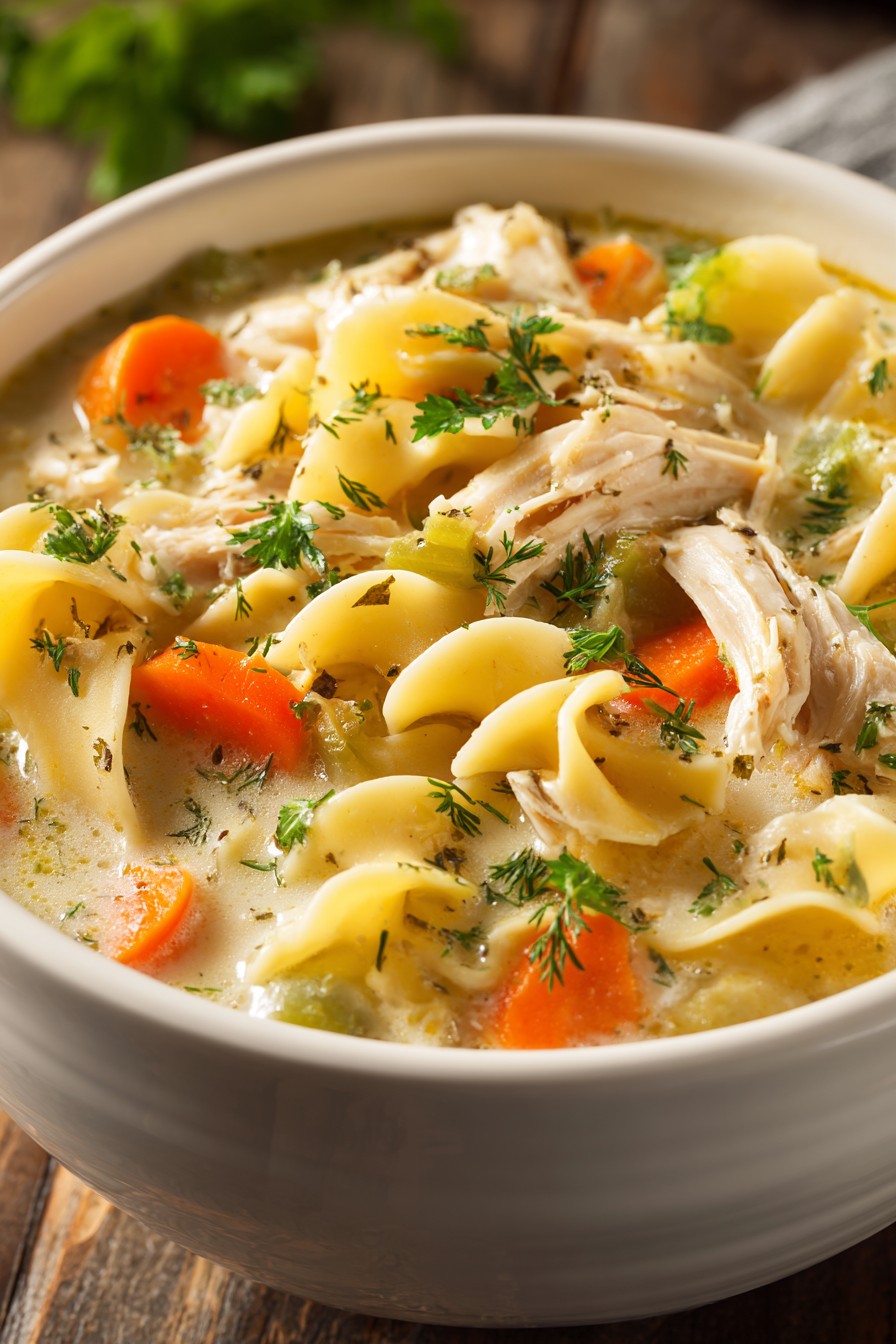Sick of watery, bland chicken noodle soup that leaves you craving more substance? Sometimes you need a bowl that sticks to your ribs and warms your soul from the inside out. This thick chicken noodle recipe transforms the classic into a hearty, satisfying meal that’s perfect for chilly nights or when you need serious comfort food therapy.
Why This Recipe Works
- The secret to our ultra-thick broth lies in creating a rich roux with butter and flour, which not only thickens the soup beautifully but also adds a subtle nutty flavor that store-bought thickeners can’t match.
- We use both shredded chicken thighs and drumsticks for maximum flavor – the thighs provide incredible richness while the drumsticks contribute gelatin that naturally thickens the broth as it simmers.
- Instead of boiling the noodles separately, we cook them directly in the broth during the final 15 minutes, allowing them to absorb all the delicious flavors while releasing starch that further enhances the thickness.
- A generous amount of fresh vegetables including carrots, celery, and onions are sautéed until deeply caramelized, creating a flavor foundation that makes this soup taste like it’s been simmering for hours rather than just over an hour.
- The finishing touch of fresh herbs and a splash of heavy cream adds brightness and luxurious richness that elevates this from simple soup to restaurant-quality comfort food.
Ingredients
- 2 pounds bone-in chicken thighs and drumsticks (skin removed)
- 1/2 cup unsalted butter
- 3/4 cup all-purpose flour
- 2 large yellow onions, finely diced
- 4 large carrots, peeled and sliced into 1/4-inch rounds
- 4 celery stalks, finely chopped
- 6 cloves garlic, minced
- 12 cups chicken broth (preferably low-sodium)
- 1 pound wide egg noodles
- 1 cup heavy cream
- 1/4 cup fresh parsley, chopped
- 2 tablespoons fresh dill, chopped
- 2 bay leaves
- 1 teaspoon dried thyme
- Salt and black pepper to taste
Equipment Needed
- Large 8-quart stockpot or Dutch oven
- Wooden spoon or spatula
- Chef’s knife and cutting board
- Measuring cups and spoons
- Tongs for handling chicken
- Ladle for serving
- Whisk (for smoothing the roux)
Instructions

Prepare and Brown the Chicken
Begin by patting your chicken pieces completely dry with paper towels – this is crucial for achieving that beautiful golden-brown sear rather than steaming in their own moisture. Season all sides generously with salt and pepper, don’t be shy here as this forms the foundation of your flavor. Heat 2 tablespoons of butter in your large stockpot over medium-high heat until it’s sizzling but not smoking. Carefully place the chicken pieces in a single layer, working in batches if necessary to avoid overcrowding the pot. Cook for about 5-7 minutes per side until you achieve a deep golden-brown crust that releases easily from the pot bottom. The chicken won’t be cooked through at this stage – that’s perfectly intentional as it will finish cooking in the broth later. Remove the chicken to a plate and set aside, reserving those delicious browned bits in the pot for building flavor.
Create the Flavor Base and Roux
Reduce the heat to medium and add the remaining butter to the same pot, scraping up all those glorious browned bits from the chicken with your wooden spoon. Once the butter melts, add your diced onions, carrots, and celery, stirring to coat them in the butter. Cook for 8-10 minutes, stirring occasionally, until the vegetables have softened and the onions become translucent with slightly golden edges. Sprinkle the flour evenly over the vegetables and immediately start stirring continuously – you’re making a roux that will thicken your entire soup. Cook this mixture for exactly 3-4 minutes until the raw flour smell disappears and it takes on a light golden color, stirring constantly to prevent burning. This step is non-negotiable for achieving that perfect thickness and eliminating any starchy taste from the flour.
Build the Broth and Simmer
Slowly pour in your chicken broth about 2 cups at a time, whisking vigorously after each addition to completely incorporate the roux and prevent lumps from forming. Once all the broth is added, return the browned chicken pieces to the pot along with any accumulated juices from the plate. Add the bay leaves, dried thyme, and a generous pinch of black pepper. Bring the mixture to a gentle boil over high heat, then immediately reduce to a low simmer. Partially cover the pot and let it simmer gently for 45 minutes – you should see occasional bubbles breaking the surface but not a rolling boil. This slow cooking allows the chicken to become fall-apart tender while the broth develops deep, complex flavors.
Shred Chicken and Add Noodles
After 45 minutes, use tongs to remove the chicken pieces to a cutting board – they should be extremely tender and practically falling off the bone. Let them cool slightly until you can handle them, then shred the meat using two forks, discarding the bones and any cartilage. While the chicken cools, increase the heat to medium-high and bring the broth back to a steady boil. Add the egg noodles and cook for exactly 12-15 minutes, stirring occasionally to prevent sticking, until the noodles are al dente but still have a slight bite. The broth will thicken significantly during this step as the noodles release their starch – this is exactly what we want for our ultra-thick consistency.
Final Seasoning and Serving
Reduce the heat to low and return the shredded chicken to the pot. Stir in the heavy cream, fresh parsley, and fresh dill, warming through for about 2-3 minutes until everything is heated evenly but not boiling. Taste and adjust seasoning with additional salt and pepper – remember the broth was low-sodium so you’ll likely need more salt than you think. Remove the bay leaves and discard them. Let the soup rest off the heat for 5 minutes before serving – this allows the flavors to meld together and the thickness to perfect itself. Ladle into deep bowls and enjoy immediately while it’s piping hot for the ultimate comfort food experience.
Tips and Tricks
For the absolute best flavor development, consider making your own chicken broth from scratch using the bones after shredding the chicken. Simply return the bones to the pot with additional water and simmer for another hour before proceeding with the recipe – this extra step creates an incredibly rich, gelatinous broth that takes the thickness to another level. If you’re short on time, enhance store-bought broth by simmering it with the chicken bones for 30 minutes before starting the roux step.
The type of noodles you choose dramatically affects the final thickness. Wide egg noodles work best because they release more starch than other varieties, but if you prefer different noodles, adjust the cooking time accordingly and consider adding an extra tablespoon of flour to your roux. For gluten-free options, use brown rice flour in the roux and gluten-free noodles, but note they may require less cooking time and produce a slightly different texture.
Timing is everything with the roux – cook it long enough to lose the raw flour taste but not so long that it becomes dark brown, which would create a nutty flavor that might overpower the chicken. The perfect roux for this soup should be pale golden and smooth. If you accidentally get lumps, don’t panic – simply strain the broth after adding it and before adding the noodles, then return it to the pot.
For make-ahead convenience, you can prepare the soup through the simmering step, then cool completely and refrigerate for up to 3 days. When ready to serve, reheat gently, then proceed with cooking the noodles fresh – this prevents them from becoming mushy. The soup also freezes beautifully without the noodles and cream – add those after thawing and reheating.
If your soup becomes too thick upon standing (the noodles continue absorbing liquid), simply thin it with additional warm broth or water until it reaches your desired consistency. Conversely, if it’s thinner than you prefer, make a quick slurry of 2 tablespoons cornstarch mixed with 1/4 cup cold water, then stir it into the simmering soup until thickened.
Recipe Variations
- Creamy Mushroom Chicken Noodle: Add 8 ounces of sliced cremini mushrooms when sautéing the vegetables. For extra richness, use 1 cup of dry white wine to deglaze the pan after browning the chicken, letting it reduce by half before adding the broth. Finish with a tablespoon of fresh thyme instead of dill for an earthy, sophisticated twist that transforms this into company-worthy fare.
- Spicy Southwest Style: Replace the traditional vegetables with 1 diced poblano pepper, 1 red bell pepper, and 1 cup of corn kernels. Add 1 tablespoon of chili powder, 2 teaspoons of cumin, and 1/2 teaspoon of chipotle powder to the roux. Use pepper jack cheese instead of cream for thickening, stirring in 2 cups shredded at the end until melted. Top with avocado slices and cilantro for a Tex-Mex inspired bowl.
- Italian Wedding Soup Twist: Form 1 pound of ground chicken mixed with 1/4 cup breadcrumbs, 1 egg, and Italian seasoning into small meatballs. Brown these separately before adding to the broth. Use pastina or orzo instead of egg noodles, and add 2 cups of chopped spinach during the last 5 minutes of cooking. Finish with grated Parmesan and a squeeze of lemon for brightness.
- Thai Coconut Curry Version: Replace the butter with coconut oil and the flour with 2 tablespoons of red curry paste. Use coconut milk instead of heavy cream, and add 1 tablespoon of fish sauce and 1 tablespoon of brown sugar. Swap the egg noodles for rice noodles cooked separately, and garnish with lime wedges, fresh basil, and chopped peanuts for an Asian-inspired comfort bowl.
Frequently Asked Questions
Can I use boneless chicken breasts instead of thighs and drumsticks?
While you can technically use boneless, skinless chicken breasts, I strongly recommend against it for this particular recipe. Chicken thighs and drumsticks contain more collagen and fat, which melts during cooking to create a naturally richer, thicker broth and more tender meat. Breasts tend to become dry and stringy when simmered for this length of time, and they won’t contribute the same gelatinous quality that helps achieve our desired thickness. If you must use breasts, reduce the simmering time to 25 minutes and consider adding a tablespoon of unflavored gelatin to compensate for the missing collagen.
Why did my soup become too thick after refrigeration?
This is completely normal and actually a sign that you made the soup correctly! The noodles continue to absorb liquid as they sit, and the fat from the chicken and cream solidifies when chilled, creating a very thick consistency. Simply reheat gently on the stove, adding warm chicken broth or water a half-cup at a time until it reaches your preferred thickness. The soup will return to its perfect creamy state once heated through. This thickness is actually ideal for freezing, as it prevents the noodles from becoming mushy when thawed.
Can I make this recipe in a slow cooker or Instant Pot?
Absolutely, but with some modifications. For slow cooker: Brown the chicken and make the roux on the stove first, then transfer everything except the noodles and cream to the slow cooker. Cook on low for 6-8 hours, then remove chicken to shred. Add noodles and cook on high for 20-30 minutes until tender, then stir in cream. For Instant Pot: Use sauté function to brown chicken and make roux, then pressure cook on high for 15 minutes with natural release. Remove chicken, add noodles, and sauté for 8-10 minutes until noodles are cooked, then add cream.
How long will leftovers keep in the refrigerator?
Properly stored in an airtight container, your chicken noodle soup will keep for 3-4 days in the refrigerator. The noodles will continue to absorb liquid, so you’ll need to add more broth when reheating. For best quality, I recommend storing the soup without the noodles if you know you’ll have leftovers – cook fresh noodles each time you reheat a portion. The soup freezes beautifully for up to 3 months if you omit the noodles and cream; add those after thawing and reheating.
Summary
This ultra-thick chicken noodle soup combines tender shredded chicken, hearty vegetables, and wide egg noodles in a luxuriously creamy broth that’s comfort food perfection. With pro tips for maximum flavor and thickness, it’s sure to become your go-to cozy meal.
Thick Chicken Noodle Soup
4
servings20
minutes1
minutesIngredients
Instructions
- 1 Brown chicken in butter, then remove and set aside.
- 2 Sauté vegetables, then make roux with flour.
- 3 Gradually add broth, return chicken, and simmer 45 minutes.
- 4 Remove chicken, shred, then cook noodles in broth.
- 5 Return chicken, add cream and herbs, then serve.



